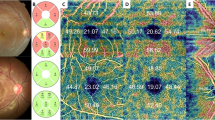Abstract
Purpose
The aim of the study was to evaluate the relationship between visual function and retinal nerve fiber layer thickness (RNFLT) determined using Stratus optical coherence tomography (OCT) in patients with autosomal dominant optic atrophy (ADOA).
Methods
The study was a retrospective, institutional, and comparative case series. Thirty-six consecutive patients with ADOA and 72 age-matched normal controls were compared with regard to RNFLT, best-corrected visual acuity (BCVA), and visual field.
Results
The relative reduction of RNFLT of ADOA patients was most evident in the temporal quadrant (56.8 %), followed by the inferior (35.5 %), superior (27.2 %), and nasal quadrants (26.4 %). In ADOA patients, BCVA decreased with RNFL thinning (p < 0.001), and was not related to age (p = 0.210). Papillomacular bundle RNFLT decreased with age throughout the study period of 3.7 ± 2.3 years (−3.83 ± 9.96 μm, p = 0.017). The presence of a superotemporal central scotoma (61.1 %) was related to decreased inferotemporal RNFLT (7 and 8 o’clock, p = 0.016 and p = 0.036, respectively).
Conclusions
The papillomacular bundle RNFL of ADOA is most vulnerable and progressively damaged with age, despite early temporal RNFL loss. Early loss of inferior temporal RNFL in ADOA is related to superotemporal central scotoma.
Similar content being viewed by others
References
Kjer P (1959) Infantile optic atrophy with dominant mode of inheritance: a clinical and genetic study of 19 Danish families. Acta Ophthalmol (Copenh) 164:1–147
Teesalu P, Tuulonen A, Airaksinen PJ (2000) Optical coherence tomography and localized defects of the retinal nerve fiber layer. Acta Ophthalmol Scand 78:49–52
Votruba M, Thiselton D, Bhattacharya SS (2003) Optic disc morphology of patients with OPA1 autosomal dominant optic atrophy. Br J Ophthalmol 87:48–53
Milea D, Sander B, Wegener M et al (2010) Axonal loss occurs early in dominant optic atrophy. Acta Ophthalmol 88:342–346
Kim TW, Hwang JM (2007) Stratus OCT in dominant optic atrophy: features differentiating it from glaucoma. J Glaucoma 16:655–658
Barboni P, Savini G, Parisi V et al (2011) Retinal nerve fiber layer thickness in dominant optic atrophy measurements by optical coherence tomography and correlation with age. Ophthalmology 118:2076–2080
Yu-Wai-Man P, Bailie M, Atawan A et al (2011) Pattern of retinal ganglion cell loss in dominant optic atrophy due to OPA1 mutations. Eye (Lond) 25:596–602
Mikelberg FS, Drance SM, Schulzer M et al (1989) The normal human optic nerve. Axon count and axon diameter distribution. Ophthalmology 96:1325–1328
Pan BX, Ross-Cisneros FN, Carelli V et al (2012) Mathematically modeling the involvement of axons in Leber’s hereditary optic neuropathy. Invest Ophthalmol Vis Sci 53:7608–7617
Jansonius NM, Nevalainen J, Selig B et al (2009) A mathematical description of nerve fiber bundle trajectories and their variability in the human retina. Vision Res 49:2157–2163
Johnston PB, Gaster RN, Smith VC et al (1979) A clinicopathologic study of autosomal dominant optic atrophy. Am J Ophthalmol 88:868–875
Kjer P, Jensen OA, Klinken L (1983) Histopathology of eye, optic nerve and brain in a case of dominant optic atrophy. Acta Ophthalmol (Copenh) 61:300–312
Ito Y, Nakamura M, Yamakoshi T et al (2007) Reduction of inner retinal thickness in patients with autosomal dominant optic atrophy associated with OPA1 mutations. Invest Ophthalmol Vis Sci 48:4079–4086
Votruba M, Fitzke FW, Holder GE et al (1998) Clinical features in affected individuals from 21 pedigrees with dominant optic atrophy. Arch Ophthalmol 116:351–358
Wakakura M, Fujie W, Emoto Y (2009) Initial temporal field defect in Leber hereditary optic neuropathy. Jpn J Ophthalmol 53:603–607
Acknowledgments
None of the authors have any financial interests to disclose.
Conflicts of interest
None.
Author information
Authors and Affiliations
Corresponding author
Rights and permissions
About this article
Cite this article
Park, S.W., Hwang, JM. Optical coherence tomography shows early loss of the inferior temporal quadrant retinal nerve fiber layer in autosomal dominant optic atrophy. Graefes Arch Clin Exp Ophthalmol 253, 135–141 (2015). https://doi.org/10.1007/s00417-014-2852-7
Received:
Revised:
Accepted:
Published:
Issue Date:
DOI: https://doi.org/10.1007/s00417-014-2852-7




